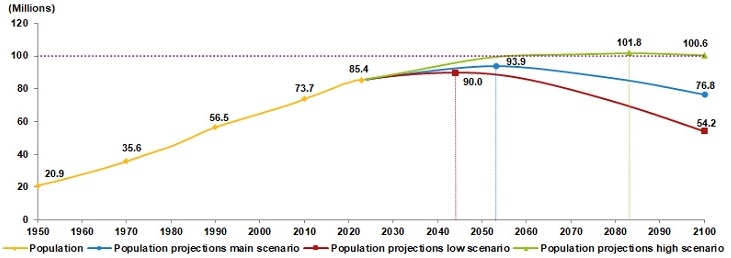Turkish Statistical Institute (TurkStat) has renewed its population projections for the period between 2023 and 2100.
Estimated population projections were published under three headings: low, main and high scenarios. In the report, it is stated that the increasing population will start to decline within 20 to 30 years due to the decline in fertility rate. The report stated that the population will continue to age and one out of every three people is expected to be elderly in 2075.
According to TurkStat data, the proportion of the working-age population is projected to be approximately 55 percent in 2100.
Population figures and population projections by years, 1950-2100

‘THE DECLINE IN THE FERTILITY RATE IN TURKEY HAS IMPLICATIONS ON POPULATION PROJECTIONS’
In the report published by TurkStat, it is stated that the decline in the fertility rate and the change in the international migration trend have led to different projections.
According to TurkStat’s main scenario, Turkey’s population is expected to increase until the mid-2050s and then decline, falling below 77 million in 2100.
According to TurkStat’s low scenario, which assumes that “the rapid downward trend in fertility indicators to continue”, Turkey’s population is expected to fall below 55 million in 2100;
According to the high scenario, which assumes that “measures to increase fertility will be effective”, Turkey’s population is expected to exceed 100 million in 2056.
‘TURKISH POPULATION WILL CONTINUE TO AGING’
The report states that Turkey’s population will continue to age. In all three scenarios of TurkStat, the population shows an aging trend.
According to TurkStat’s data, while the median age is 34, it is expected to reach 44.8 in 2050 according to the main scenario, 51.5 in 2075 and 52.2 in 2100.
‘1 IN EVERY 3 PEOPLE IN TURKEY IS EXPECTED TO BE ELDERLY IN 2075’
According to the population results announced by TurkStat, the proportion of the elderly population in the total population rose above 10 percent for the first time this year.
According to TurkStat’s main scenario, the proportion of the elderly population is expected to reach 23.1 percent in 2050, 31.7 percent in 2075 and 33.6 percent in 2100. This year, the proportion of the working age population in the 15-64 age group is 68.3 percent.
According to the main scenario, the proportion of the working-age population is expected to be 61.9 percent in 2050, 55.9 percent in 2075 and 54.6 percent in 2100.
According to the TurkStat report, the proportion of the population in the 0-14 age group, defined as the child population, is 21.4 percent this year. According to the main scenario, the proportion of the child population is expected to be 15.1 percent in 2050, 12.4 percent in 2075 and 11.8 percent in 2100.
‘THE DEMOGRAPHIC OPPORTUNITY WINDOW IS PROJECTED TO CLOSE IN THE FIRST HALF OF 2030’
The period when the total dependent population is less than half of the working age population is called the “demographic window of opportunity”.
The demographic window of opportunity is considered to be open when the population under the age of 15, defined as the child population, is less than 30 percent of the total population and the population over the age of 65, defined as the elderly population, is less than 15 percent of the total population. In the projection results of TurkStat, it is stated that the ratio of the elderly population will exceed 15 percent in the first half of 2030 and the demographic window of opportunity will close.
